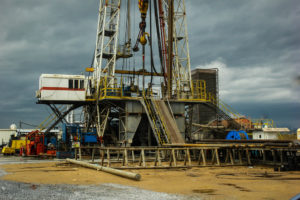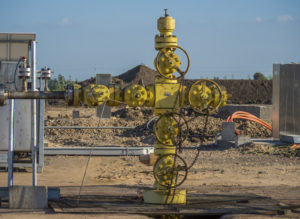Upstream - Oil and Gas Wells - Flow Lines
Upstream production start at the wells itself. Where upstream ends is not clear defined. The definition varies from company to company, and the part of the world or region, where the oil or the gas is produced.
Drilling oil and gas wells
Drilling exploration wells is the first step in developing an oil field or oil or gas wells. In the sea or in lakes offshore drilling rigs are used for this task. These are manned offshore platforms, specifically designed to find oil or gas on the seabed. Today's technologies make it possible to drill for oil almost every where on earth. Close to the shore in shallow water, also drilling at sea depths of more than 3500 meters or 11000 feet.

Onshore, where the land can be accessed by trucks and heavy equipement, a drilling rig is set up direct on the ground.
Before the drilling was done straight down only. Once the drilling has reached the oil reservoir, the crude oil or the natural gas comes up to the surface by itself, due to the over pressure down in the well.
Today drilling companies drill not only vertical down in the ground. With modern drill pipes used today, it is possible to make curves during drilling and change direction to horizontal. This technology is used a lot for fracking, where horizontal wells are needed to crack the shale.
Once the well is drilled, it is closed with a valve and ready for production of oil and gas.
Upstream production
In the oil sector, only a few wells supply crude oil by natural flow. Once the pressure in the reservoir drops, either the pressure must be maintained by replacing the fluid produced with another fluid, to keep the crude oil running.
Or the liquid must be pumped out of the wells to bring crude oil to the surface. Pump Jacks, sometimes called donkeys, are used in oil-rich areas. This pump moves a rod up and down in the well. With a combination of valves, the fluid is released during the upstroke. In this way such a pump can produce 5 to 50 litres of liquid per stroke.
When pumping 500 barrels/day or more, so-called electric submersible pumps, ESP for short, are used. An ESP is brought down through the tubing into the well. The ESP has to be fixed in the tubing so it is positioned in the liquid. The ESP needs a power cable from the surface.
Flow lines
 Ontop of each well a so called christmas tree is installed. See the picture, the flow line is connected on the left side. With such a unit on top of the well, the well can be closed, instruments can be connected and a most important flow line. The silutte of this unit looks from far away as a christmas tree, therefore the name. This flow line is usually made out of steal and transport the oil or gas, from the well to a storage facility.
Ontop of each well a so called christmas tree is installed. See the picture, the flow line is connected on the left side. With such a unit on top of the well, the well can be closed, instruments can be connected and a most important flow line. The silutte of this unit looks from far away as a christmas tree, therefore the name. This flow line is usually made out of steal and transport the oil or gas, from the well to a storage facility.
This storage facility can be a tank close by, or a tank farm in the area. In Canada or in Texas, where the oil wells are spread over the fields, there is just one tank direct next to the well. The oil from the tank is taken by truck to a central place.
If in one area there are a lot of wells, or if the wells produces a lot of crude oil, then all of the wells are connected by flowlines to the storage tanks. Such flowlines are rather small and usual not more then 3 miles long.
Upstream Merus does
- treating the oil well or gas well against corrosion, scaling, waxing, either by gas lift or with a downhole tool.
- treating flow lines against waxing, corrosion, scaling fouling.
Continue reading about midstream or downstream
